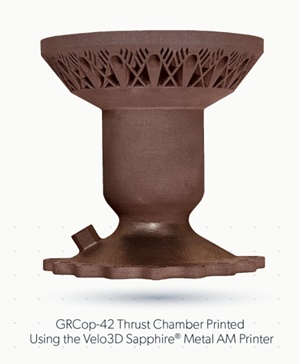CAMPBELL, CA, USA, May 9, 2022 – Velo3D, Inc. (NYSE: VLD), a leading metal additive manufacturing technology company for mission-critical parts, has qualified the copper-chromium-niobium alloy GRCop-42 for use in its Sapphire family of printers. The first GRCop-42 demo parts will be on display at the Velo3D RAPID +TCT booth (#1508) in Detroit on May 17-19.

The GRCop-42 alloy was developed by NASA to manufacture parts in need of high-strength and high-conductivity, such as rocket engine combustion chambers with regenerative cooling. Velo3D customers can use the newly-developed material parameters to produce mission-critical parts with oxidation resistance and high creep strength at temperatures as high as 1400 degrees Fahrenheit.
“Our end-to-end solutions have seen extensive adoption in aerospace because of their ability to deliver part consolidation, lighter-weight systems, and unique geometries, and adding GRCop-42 to our growing list of available materials enables us to support more use cases across the aerospace industry,” said Benny Buller, Velo3D CEO and Founder. “We’ve had extensive demand for Sapphires and Sapphire XCs that can print GRCop-42 and we’ve tested it to ensure it can achieve the same high-quality builds as our other offered materials. I’m looking forward to seeing how customers unlock new use-cases for additive manufacturing with this amazing alloy.”
GRCop-42 was developed by NASA in 1987 for use in harsh environments that are commonly found in rocket engine combustion chambers. The alloy was created after research teams identified ways to make improvements to previously-developed copper alloys. GRCop-42 stood out due to its ability to achieve higher thermal conductivity compared to its predecessor while achieving similar strength properties. In 2017, NASA developed parameters for GRCop-42’s use in additive manufacturing at its Marshall Space Flight Center in Alabama and Glenn Research Center in Ohio.
Velo3D contract manufacturer Knust Godwin will receive the first Sapphire printer utilizing GRCop-42. The Texas-based company has three systems currently in place including other alloys, such as Inconel. Knust Godwin’s parent company Schoeller-Bleckmann Oilfield Equipment, which is headquartered in Austria, also has a Velo3D end-to-end solution.
“Our team is always looking for new ways to differentiate our business and because of that we were an early adopter of additive manufacturing technology, which has helped us grow our business and better serve our customers,” said Mike Corliss, Knust Godwin VP of Technology. “Additive manufacturing allows us to build parts for our customers that could not otherwise be manufactured using conventional, subtractive manufacturing. These new, powerful alloys, like GRCop-42—that provide added capabilities and benefits for our customers—allow us to expand our addressable use-cases.”
With broad adoption of its end-to-end solution in the aerospace industry, Velo3D’s qualification of GRCop-42 for use in its Sapphire family of printers is a natural next step in its material offering. The company is one of the few with printers able to build parts in GRCop-42 and currently has several such systems on order. Prior to offering the material to customers, GRCop-42 was validated to ensure it delivers the same expected outcomes and part quality as other materials offered by Velo3D.
About Velo3D
Velo3D is a metal 3D printing technology company. 3D printing—also known as additive manufacturing (AM)—has a unique ability to improve the way high-value metal parts are built. However, legacy metal AM has been greatly limited in its capabilities since its invention almost 30 years ago. This has prevented the technology from being used to create the most valuable and impactful parts, restricting its use to specific niches where the limitations were acceptable.
Velo3D has overcome these limitations so engineers can design and print the parts they want. The company’s solution unlocks a wide breadth of design freedom and enables customers in space exploration, aviation, power generation, energy and semiconductor to innovate the future in their respective industries. Using Velo3D, these customers can now build mission-critical metal parts that were previously impossible to manufacture. The end-to-end solution includes the Flow print preparation software, the Sapphire family of printers, and the Assure quality control system—all of which are powered by Velo3D’s Intelligent Fusion manufacturing process. The company delivered its first Sapphire system in 2018 and has been a strategic partner to innovators such as SpaceX, Honeywell, Honda, Chromalloy, and Lam Research. Velo3D has been named to Fast Company’s prestigious annual list of the World’s Most Innovative Companies for 2021. For more information, please visit Velo3D.com, or follow the company on LinkedIn or Twitter.


